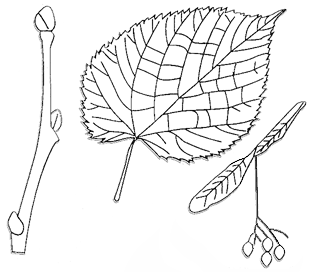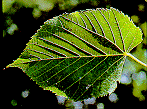Tilia americana
Leaves are alternate, simple, double-toothed with unequal leaf bases.
 The basswood is a large, wide-spreading, round-topped tree with dense foliage. The basswood has
been widely planted for street trees. The tree blossoms in late May or June, and the blossoms are a
favorite with bees, yielding large quantities of honey.
The basswood is a large, wide-spreading, round-topped tree with dense foliage. The basswood has
been widely planted for street trees. The tree blossoms in late May or June, and the blossoms are a
favorite with bees, yielding large quantities of honey.
The leaves are rounded or heart-shaped, with toothed margins and with one side of the base less rounded than the other. They are dull green above and lighter green beneath. They vary quite widely in size from 4 to 7 inched long.
 The
twigs are smooth and light brown to gray in color. The bark is light or silvery gray, and smooth or
finely ridged on branches and young trunks. On older trunks the bark breaks into long,
medium-narrow ridges and furrows, dark gray to almost black on the surface.
The
twigs are smooth and light brown to gray in color. The bark is light or silvery gray, and smooth or
finely ridged on branches and young trunks. On older trunks the bark breaks into long,
medium-narrow ridges and furrows, dark gray to almost black on the surface.
The tree has a very distinct fruit. It is an open cluster of hard nutlets borne on a stem which comes from the center of a narrow, elliptical, leaflike wing.
Leaves: -heart-shaped, fine-toothed edges, with uneven bases. Green and red give the leaves a purplish hue in fall.
Branching: alternate
Bark: grayish with tight even furrows
Height: 70 to 80 ft.
Trunk Diameter: 2 to 3 ft.
Longevity: matures in 90 to 140 yrs.
Tolerance: moderately tolerant
Range: eastern U.S., to southern Tennessee and western Virginia.
Fun Facts:
- Timber widely used for wood carving.
- Iroquois Indians made rope from the bark by soaking it in water for several days; it was then twisted into the desired form.
- Often has stump sprouts at base of tree.
- Knock on the trunk to hear a hollow sound.
- Edible buds.
![]()